SEARCH OUR PLANTS
To locate perennials by BOTANICAL NAME, click on the first letter of the name below.
A • B • C • D • E • F • G • H • I • J • K • L • M • N • O • P • Q • R • S • T • U • V • W • X • Y • Z
|
Botanical / Common Name
|
Description
|
Photo
|
| Acanthus 'Caroli- Alexandri' Bear's Breech |
Despite the boldness of its leaves, which have deeply cut and pointed margins, it is a compact grower, at home even in a large container. In full sun, bear’s breeches produces equally dramatic, pagoda-like inflorescences, up to three feet tall. These are composed of tiers of hooded flowers. Each flower has a sharp spine, so be careful when handling them. Because bear’s breeches grows well in sun or part shade.
|
|
| Acanthus hungaricus Bear's Breech |
Tolerates wide range of soils except poorly-drained ones. Appreciates some afternoon shade in hot summer climates. An erect, clump-forming perennial which features pale pink to white flowers enclosed in spiny, reddish-purple bracts and arranged in vertical rows on substantial flower spikes rising well above the foliage to 3-4' tall. Blooms in late spring to early summer. Deeply lobed glossy green leaves (2-3' long) form an ornamental mound which usually remains attractive throughout the growing season.
|
 |
| Acanthus mollis Bear's Breech |
May not flower well in too much shade. Late spring frosts can impair or eliminate flowering for the year. Remove flowering stalks after bloom. In cold winter areas, plant foliage should be left in place over winter but removed in early spring as new foliage appears. Plants can spread aggressively by creeping rootstocks, particularly in loose soils. This species of bear’s breeches is a clump-forming perennial that is grown as much for its attractive foliage as for its architecturally bold white flower spikes with rich purple hoods.
|
|
| Acanthus spinosus Bear's Breech |
Blooms from late spring into mid summer. Deeply-cut, arching, glossy green, spiny, thistle-like leaves (2-3' long) form an ornamental mound of long-stalked, basal foliage which usually remains attractive throughout the growing season. The leaves of A. spinosus are more deeply cut and have rigid spines (hence the species name) at the lobe tips than other Acanthus. The Acanthus leaf has a classic appearance and are the source of the Corinthian leaf motif developed and used as a decoration in ancient Greek and Roman art and architecture.
|
|
| Achillea 'Coronation Gold' Common Yarrow |
Best grown in dry to medium moisture, well-drained sandy loams in full sun. Tolerates poor soils as long as drainage is good. Avoid heavy clays and moist, rich, fertile soils. Tolerates hot, humid summers and drought, and is considered to be one of the best yarrows in the Mid-Atlantic climate.
|
|
| Achillea filipendulina 'Parker's Variety' Common Yarrow |
'Parker's Variety' is an upright, clump-forming yarrow which is noted for its deeply-dissected, fern-like, aromatic, grayish-green to green foliage and its tiny, long-lasting, bright golden flowers which appear in dense, flattened, plate-like compound corymbs (to 4" across) throughout the summer on stiff, erect stems typically rising 3-4' tall. Foliage has a strong, somewhat spicy aroma which persists when used in dried arrangements.
|
|
| Achillea millefolium 'Apfelblute' Common Yarrow |
Two-foot tall thinly leafed stems of 'Appleblossom' yarrow (Achillea millefolium 'Appleblossom') is crowned by large flat corymbs consisting of tiny blossoms, in sundry soft shades of pink fading into a dusty off-white. Bred in Germany, its actual name is 'Apfelblute,' rendered into English as one word, but occasionally as Apple Blossom. Millefolium means "thousand-leaf" in reference to its fern-like foliage. Although many authorities list 'Paprika' as one of the Galaxy Hybrids (A. millefolium x A. 'Taygetea'), The Royal Horticultural Society Index of Garden Plants and the American Horticultural Society A to Z Encyclopedia of Garden Plants both consider it to be a cultivar of A. millefolium. Achillea millefolium and its cultivars have a more spreading habit than some of the taller, clump-forming yarrows such as A. filipendulina. All Achillea benefit from cutting the flowers for arrangements or dead-heading as it will extend the blooming time.
|
|
| Achillea millefolium 'Cerise Queen' Common Yarrow |
rom early to midsummer, yarrow 'Cerise Queen' displays large, flat-topped clusters of vibrant, magenta-pink flowers with tiny white centers. These are borne on slender, sturdy stems which rise from vigorous clumps of bright green, ferny foliage. The bright blooms are irresistible to butterflies, and also make excellent cut flowers.
|
|
| Achillea millefolium 'Heidi' Common Yarrow |
This selection has clusters of bright cherry-pink flowers, fading to pale-pink and creamy yellow. Fragrant, ferny green foliage. Excellent for cutting, fresh or dried. Remove faded flowers regularly to promote continued blooming. Inclined to spread, so site this carefully or plan to reduce the clumps each spring. Easily divided in fall or early spring. Trim back hard after the first flush of bloom to maintain a compact habit. Heat tolerant.
|
|
| Achillea millefolium'Hoffnung' Common Yarrow |
Bears pale yellow and fragrant flowers during early summer to early fall. The foliage is deep green in colour. tolerates drought, and is noted for being naturally resistant to deer and rabbits. is fast and you should plan for this in your garden design and layout.
|
|
| Achillea millefolium 'Lachsschonheit' Common Yarrow |
A. 'Salmon Beauty' Salmon pink flowers fading to pale pink. For sun and well drained moist soil. Very large plants
|
|
| Achillea millefolium 'Paprika' Common Yarrow |
'Paprika' is a spreading, mat-forming common yarrow cultivar with deeply-dissected, fern-like, aromatic, foliage. Its tiny, long-lasting, dusty-red flowers with yellow centers appear in dense, flattened, compound blooms are 2-3" across. It blooms throughout the summer then fades, sometimes rather quickly, to light pink or even a creamy yellow. Foliage has a strong, somewhat spicy aroma which dries nicely for long-lasting flower arrangements.
|
|
| Achillea millefolium 'Red Beauty' Common Yarrow |
‘Red Beauty’ is a rhizomatous, spreading, upright yarrow cultivar that is noted for its cerise-red flowers and ferny aromatic foliage. Flowers appear in dense, flattened clusters (compound corymbs to 2-4” across) over a long summer bloom on stems typically rising to 18-24” tall. Deeply-dissected, fern-like, medium green leaves have a strong, somewhat spicy aroma that may persist when used in dried arrangements.
|
|
| Achillea millefolium 'Moonshine' Common Yarrow |
Clump forming yarrow with striking silver-green foliage and flat clusters of pleasant yellow flowers from June through September. The flowers are very long lasting and are wonderful for cutting and drying. Deadhead the flowers for re-bloom and cut back to the basil leaf after bloom has finished. This is a compact variety of Yarrow with a 2’ height and spread making it a great plant for front borders. Moonshine needs good drainage and can take poor to moderate soils, but avoid clay and rich soils. Achillea millefolium ‘Moonshine’ is deer and rabbit resistant.
|
|
| Achillea ptarmica 'The Pearl' Common Yarrow |
A profusion of button-like, pure white, 1/2" wide, double flowers resembling pompons in large branched heads on stems up to 2 feet. Unlike most other yarrows, this species features lance-shaped leaves which are neither deeply dissected nor fern-like in appearance. Excellent cut and dried flower. Tolerant of summer heat and humidity. Over time, a number of Achillea ptarmica clones or seed-raised plants with double flowers have been sold under the cultivar name of 'The Pearl' resulting in what should more accurately be referred to as a group, namely, The Pearl Group.
|
|
| Achillea ptarmica 'Walther Funcke' Common Yarrow |
A really deep warm orange tone. The hottest color of the Achillea and makes a strong border or focal point in the garden.
|
|
| Achillea ptarmica 'Schwellenburg' Common Yarrow |
A low-growing, spreading plant featuring deep gold, flat, terminal flower heads atop stiff stems with deeply-cut, fern-like, silver-gray leaves. Foliage is aromatic when crushed. Good cut or dried flower. Tolerant of summer heat and humidity. Drought tolerant once established. Long summer bloom period may be extended by prompt removal of faded flower heads.
|
|
| Achillea ptarmica 'Terra Cotta' Common Yarrow |
Displays a multi-colored effect, the younger, emerging bright peach flower slowly changes into a clay pot (terra cotta) color. Silvery foliage.
|
|
| Aconitum carmichaelii 'Barker's Variety' Monkshood |
A most impressive plant for the back of the border is this superb cultivar bearing in late summer and early autumn long racemes of large and colorful flowers. The hood-shaped flowers that are held on sturdy spikes make this flowering perennial ideal for the mid to back of the cutting garden. Flowers arrive in white, light pink to dark purple and some are even bi-colored. Great cut flower. Remove spent flowers to encourage longer bloom.
|
|
| Aegopodium podagraria 'Variegatum' Angel's Wings |
This variegated goutweed is one of the most popular ground covers for quickly covering large areas. Will rapidly form a continuous mound of attractive foliage typically growing to 8" tall with an indefinite spread. Tiny white flowers appear in flat-topped, dill-like umbels which are typical of the parsley/carrot family.
|
|
| Agapanthus Lily of the Nile |
sun, massing, evergreen, 1 ft., blue flowers, Zone 7-10 | |
| Agastache Anise, Hyssop |
‘Blue Fortune’ - 2-3 ft., long lasting soft blue flower spikes, fragrant foilage, attracts butterflies, blooms July-Sept, Zone 7-9 | |
| Agastache 'Black Adder' Anise Hyssop |
Compelling violet blue buds open from deepest purple stalks. Provides color and contrast in the difficult heat of summer. Foliage is a very fragrant licorice scent that is famous for historical use in candy. Will not tolerate wet soil. This variety will not self-sow as it is sterile. A feeding trough for hummingbirds and butterflies. Blooms summer to fall. Deer Resistant. Significant compactness compared to other Agastache varieties but makes a nice showing in the perennial bed or culinary garden design.
|
|
| Agastache foeniculum 'Alba' |
This plant is very similar to anise hyssop, Agastache foeniculum, but the leaves are a brighter green color, and the small flowers are white. Butterfly and bee attracting herb that is drought tolerant once established. Interesting square stems from the mint family.
|
|
| Ajania pacifica ‘Gold and Silver’ |
Perennial ornamental with attractive lobed, ovate, silver-margined leaves. Undersides of the leaves are also silvery. It forms a dense foliage mound that spreads by rhizomes over time. It typically forms a dense foliage mound to 18-24" tall that spreads over time by rhizomes to as much as 36" wide.Bears numerous small, button-like, yellow flowers that appear in corymbs in the fall. It is quite hardy in cold climates, going completely dormant in cold-winter regions, but in warmer climes it is more-or-less evergreen (though at its best in spring and summer). To maintain the handsome foliage for which this plant is noted, periodically trim close those stems that are finished flowering or too old, encouraging fresh replacements. Cut back in spring. Excellent ground cover, rock garden companion and foreground of borders. Also known as the Pacific Chrysanthemum, the former botanical name for Silver and Gold was Chrysanthemum pacificum.
|
|
| Ajuga pyramidalis 'Metallica Crispa' Bugle Weed |
Attractive evergreen ground cover with colorful foliage and spikes of blue flowers in spring. Crinkly foliage is bronze/burgundy with a metallic sheen. Spikes of deep blue flowers in spring. Unique alternative to some of the more traditional ground cover colors because of its richness and shiny foliage.
|
|
| Ajuga reptans 'Alba' Bugle Weed |
Rare and not easily available in today’s market, this semi-evergreen ground cover is beautiful with its rich medium green foliage and upright white flowers. This unique ground hugging evergreen is most useful for light shady ground-cover. The white flower spikes appear in the spring and early summer.
|
|
| Ajuga reptans 'Burgundy Glow' Bugle Weed |
Noted for the striking range of foliage colors and textures. 'Burgundy Glow' features tricolored foliage of white, pink and green with blue flowers on 6" spikes in late spring. In mass plantings, the flower effect can be very dramatic and quite painterly. True for all A. reptans, it is easy to grow and easy to transplant. It prefers a well-drained shady location but also performs well in sunny areas. Soil should contain organic matter. A light, early spring fertilization is sufficient. Spreads rapidly.
|
|
| Ajuga reptans 'Jungle Beauty' Bugle Weed |
This evergreen ground cover adds interest to shady areas. A European native that spreads rapidly by stolons to form a dense carpet of vegetation. Spikes of pretty dark to medium blue flowers appear in late spring and early summer through the bronze and green-leaves. It can be tolerant of poor soils but perform best in those that are evenly moist and well drained. Divide plantings every two to three years to prevent overcrowding and possible disease problems. True for all A. reptans, it is easy to grow and easy to transplant. It prefers a well-drained shady location but also performs well in sunny areas. Soil should contain organic matter. A light, early spring fertilization is sufficient. Spreads rapidly.
|
|
| Ajuga reptans 'Mahogany' Bugle Weed |
Mahogany bugleweed is an evergreen to semi-evergreen, perennial groundcover with glossy leaves of dark burgundy to black. Typical Ajuga reptans needs and habit. True for all A. reptans, it is easy to grow and easy to transplant. It prefers a well-drained shady location but also performs well in sunny areas. Soil should contain organic matter. A light, early spring fertilization is sufficient. Spreads rapidly.
|
|
| Ajuga tenorii 'Chocolate Chip' Bugle Weed |
This is just the sweetest little, tight mounds of rich chocolate, purple thumb-sized and shaped foliage for the A. tenorii ‘Chocolate Chip’. It is the smallest Ajuga on the market. The deep blue flowers on 2 inch spikes help make this one of the most attractive ground covers for any landscape with some shade. It will tolerate light foot traffic between pavers as well along borders, trees and shrubs. Not ideal for a path cover that will be tread frequently.
|
|
| Alchemilla mollis ‘Auslese’ Lady's Mantle |
It is a tough perennial bearing clusters of sulphur-yellow flowers throughout summer. New foliage appears and unfolds from an accordion or fan to reveal a lotus-skinned mature leaf. Tiny hairs on its surface caused water droplets to suspend in dots from evening morning dew. It is a very unique but underutilized ground cover. This easy herb can be mowed to 3” high.
|
|
| Allium tuberosum Chinese Chives |
Garlic chives are a clump-forming onion family member which may be grown for both culinary and ornamental purposes. Features chive-like, gray-green leaves up to 12" long which may be used in cooking in the same manner as chives (Allium schoenoprasum). Tiny, star-shaped, white flowers with brown striped tepals appear in loose clusters (umbels to 2" wide) atop leafless 9-18" stems in late summer into fall. Plants will colonize, and a small planting can expand rather quickly. All parts of the plant have an oniony smell when cut or crushed, however the flower scent is more suggestive of violets.
|
|
| Amsonia 'Blue Ice' |
Blue Ice’ is a bluestar cultivar that is very similar in appearance to A. tabernaemontana except that it is much more compact and produces darker blue flowers. This is an erect, clump-forming plant that features terminal, pyramidal clusters of star-like, dark lavender-blue flowers (3/4” across) in late spring atop erect, leafy stems growing to only 15-18” tall. Narrow, willow-shaped, dark green foliage turns an attractive bright yellow in fall. Autumn is when this plant is wonderfully identifiable in a huge perennial bed.
|
|
| Amsonia hubrechtii |
Once nearly impossible to find in the market, except of course, here at Kurt Bluemel, Inc. , this plant’s attributes have been most recently recognized by more horticulturists and plantsmen. In fact, in 2010 it was awarded the Perennial Plant Associations prestigious Perennial of the Year. What causes the stir and notice is the feathery foliage in all its autumn radiance. In the spring and summer the flowers are light blue and are almost white as temperatures increase. The early flowers are easily visible, but the foliage tends to cover the later opening flowers. The narrow foliage (less than 1" wide) makes a marvelous display throughout the season, and the golden-yellow spectable in the fall is second to none among herbaceous plants.
|
|
| Amsonia illustris |
This is an erect, clump-forming plant that features terminal, pyramidal clusters of 1/2-inch, star-like, soft light blue flowers in late spring atop erect, leafy stems growing 2-3’ tall. Narrow, willow-shaped, leathery, shiny green leaves (to 6” long) may turn an attractive yellow in fall. Very similar in appearance to Amsonia tabernaemontana except the leaves of the within species are shinier, thicker and more leathery and the seed pods are pendant.
|
|
| Amsonia tabernaemontana |
Also known as, Amsonia tabernaemontana 'Montana', Amsonia tabernaemontana var. montana or Amsonia Montana. A compact, erect, clump-forming plant which features terminal, pyramidal clusters of blue, 3/4", star-like flowers in late spring atop erect, leafy stems growing up to 18" tall. Willow-shaped, green to grayish-green foliage may turn an attractive yellow in fall. The Amsonias are members of the dogbane family and are commonly called Blue Stars.
|
|
| Anemone hupehensis 'Prinz Heinrich' Windflower |
‘Prinz Henirich’ has an imcomparable flower color among the anemones with wine-red,
semi-double flowers on at 2-3 ft. rich green stand of handsome foliage.
|
|
| Anemone hupehensis 'September Charm' Windflower |
The name Anemone comes from Greek and roughly means wind flower. It signifies the effects of wind on the life-cycle of the flower. The wind that blows life into the flower by opening the petals will also in the end, blow the dead petals away. Its poetic botanical name is coupled with its poetic presence in your Summer’s-end garden. It blooms in late Sept.-Oct in part shade. Anemone is beautiful when grown in mass or at the wood’s edge. It can have up to a 10 day vase-life if cut early. ‘September Charm’ has been a market favorite for many years. 3-4 ft., pink flowers, single.
|
|
| Anemone hybrida 'Avalanche' Windflower |
part shade, massing, blooms Sept.-Oct., 2-3 ft., semi-double white flowers, Zone 5-8 | |
| Anemone hybrida 'Bressingham Glow' Windflower |
part shade, massing, blooms Sept.-Oct., 2 ft., deep pink flowers, semi-double, Zone 5-8 |
 |
| Anemone hybrida 'Hadspen Abundance' Windflower |
part shade, massing, blooms Sept.-Oct., 2-3 ft., dark pink flowers, Zone 5-8 |
 |
| Anemone hybrida 'Honorine Jobert' (A. japonica
alba) Windflower |
Rich white woodland flower with dark green deeply cut leaves. Flowers bloom in late summer - early
fall. Each stem produces a multitude of pure white 4” flowers with a velvety green center
button with vibrant orange anthers. Keeps blooming for 5 weeks or more.
|

|
| Anemone hybrida 'Konigin Charlotee' Windflower |
part shade, massing, blooms Sept.-Oct., 2-3 ft., (A.h. Queen Charlotte), pink flowers, semi-double, Zone 5-8 |
 |
| Anemone hybrida 'Margarete' Windflower |
part shade, massing, blooms Sept.-Oct., 2-3 ft, rose flowers, double, Zone 5-8 |
 |
| Anemone hybrida 'Mont Rose' Windflower |
part shade, massing, blooms Sept.-Oct., 2-3 ft., rose-pink flowers, double, Zone 5-8 |
 |
| Anemone hybrida 'Pamina' Windflower |
Smaller sized Japanese anemone. Forms thick clump of dark green deeply cut leaves. Blooms in late summer/early fall with graceful branching upright stems. The romantic flowers are rosy red with a velvety green center crowned by golden stamens. The blooms are nearly 4” across. Slow to reach mature height and spread.
|
 |
| Anemone hybrida 'Whirlwind' Windflower |
part shade, massing, blooms Sept.-Oct., 3-4 ft., white flowers, semi-double, Zone 5-8 |
 |
| Anemone japonica 'Rubra Plena' Windflower |
Massing, blooms Sept.-Oct., 2-3 ft., dark pink flowers, double
|
 |
| Anemone sylvestrisSnowdrop anemone |
Blooms early to mid spring - Flowers are white with a yellow center and slightly drooping. These fragrant little drops are easy to grow and overwinter. In harsh winter, they benefit from the protection against heavy rain and snow melt – easily remedied by planting under a spready tree. They are easily grown in containers. This Anemone proliferates by spreading their underground runners.
|
 |
| Anemone vitifolia 'Albadura' | part shade, massing, blooms Sept.-Oct., 3-4 ft., white flowers, single, Zone 5-8 |
 |
| Anemone vitifolia 'Robustissima' (A.vitifolia var. tomentosa) | part shade, massing, blooms Sept.-Oct., 'Grape-leaved Japanese Anemone' 3-4 ft., clear pink flowers, single, Zone 5-8 |
 |
| Aquilegia caerulea 'McKana Hybrids' Columbine |
Flowers form a delicate star of outer petals surrounding an inner ring with yellow centers. Long spurs project out behind the blossoms. Graceful, blue green foliage. At home in formal or cottage settings, its flowers are always a center of attention. A wealth of flowers in sun of shade and a wide range of colors: rose, blue, yellow, white, pink and crimson. The colors tend toward the pastels and the overall effect is very bright and colorful. This is the standard variety by which all others are judged.
|
 |
| Aquilegia caerulea 'Rotstern' Columbine |
'Rotstern' is a bushy, clump-forming columbine that typically grows 18-24" tall and features large, upward facing, long-spurred, primarily two-tone flowers with star-like, creamy white corollas (5 petals) and with crimson red sepals and spurs. Bushy yellow stamens add a third color. Blooms in spring. Triternate, almost fern-like, basal green foliage with a bluish tinge is somewhat suggestive of meadow rue (Thalictrum). 'Rotstern' (often translated by nurseries into English as 'Red Star' or 'Crimson Star') is frequently sold as a cultivar of A. caerulea, but may have more complex parentage and is also sometimes sold as a hybrid (often with an "x cultorum" or "x hybridus" designation). Aquilegia comes from the Latin word for eagle in reference to the flower's five spurs which purportedly resemble an eagle's talon
|
 |
| Aquilegia canadensis 'Corbett' Columbine |
‘Corbett’ is a compact version of the species that grows to only 15-18” tall and features pale yellow flowers. Flowers bloom in mid spring. Delicate, biternate, dark green foliage is somewhat suggestive of meadow rue (Thalictrum).
|
 |
| Aquilegia canadensis 'Little Lanterns' Columbine |
It features drooping, bell-like, red and yellow flowers with red spurs and a mass of bushy yellow stamens. ‘Little Lanterns’ is a compact version of the species that grows to only 10” tall. Delicate, biternate, dark green foliage is somewhat suggestive of meadow rue (Thalictrum).
|
 |
| Aquilegia flabellata var. pumila Columbine |
Var. pumila is a very compact columbine which typically grows in a mound to only 6-9" tall. It is a bushy, clump-forming perennial that features short-spurred, nodding, light to sky blue flowers with white sepals. Almost fern-like foliage shape is somewhat suggestive of Thalictrum. Leaflets of plants of this species are rounded and fan-shaped thus giving rise to the common name of fan columbine. Blooms in spring. Synonymous with A. f. 'Nana'.
|
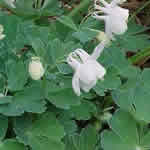 |
| Aralia cordata Japanese Spikenard |
Shrub-like, soft-stemmed, tiny white flowers in numerous small umbels arranged in long, terminal panicles appear in early summer. White flowers bloom from June – August followed by dark red berries.
|
 |
| Aralia racemosa Japanese Spikenard |
Spikenard is a shrubby-looking, soft-stemmed, Missouri native herbaceous perennial which occurs on wooded slopes, ledges and ravines in the Ozark region and in rich, moist woods of the northeast region of the State. Features smooth, branching stems typically growing 3-5' tall (less frequently to 6') and compound foliage (9-21 coarse, heart-shaped, toothed leaflets). Tiny white flowers in numerous small umbels arranged in long, terminal panicles appear in early summer.
|
 |
| Armeria maritima 'Alba' Thrift |
‘Alba’ is a sea thrift or sea pink cultivar that is noted for its grass-like foliage and globular white flower heads. This is a compact, low-growing plant which forms a dense, mounded tuft of stiff, linear, extremely narrow, grass-like, rich green leaves (to 4" long). Tufts will slowly spread outward. Tiny white flowers bloom in mid-spring in globular clusters each to 1" diameter - atop slender naked stalks rising above the foliage to 5” tall. Sporadic additional flowering may occur in summer. In the wild, species plants commonly grow in saline environments along coastal areas where few other plants can grow well, hence the common name and specific epithet.
|
 |
| Armeria maritima 'Duesseldorfer Stolz' Thrift |
A low-growing, clump-forming, compact plant featuring small, carmine-red flowers in tight, globular clusters atop wiry, naked, 6-10" stems rising up from a dense, rounded mat of stiff, grass-like, dark green leaves which spread out to 12". Good cut flower. Commonly called sea thrift because it can be found growing along sea coasts in saline environments where few other plants can survive.
|
 |
| Artemisia 'Powis Castle' Wormwood |
'Powis Castle' is a bushy, woody-based perennial or subshrub which is grown for its aromatic silvery foliage. It rarely flowers. Foliage is finely divided and feathery in appearance. Typically grows in a shrubby mound to 2-3' tall and as wide, but spreads by underground rhizomes and may reach 3-6' wide if not restrained. Essentially evergreen in warm winter climates.
|
 |
| Artemisia ludoviciana 'Silver King' Wormwood |
Artemisia ludoviciana is native to the western United States including Missouri. It is commonly called white sage because of the appearance of its foliage: lance-shaped leaves (to 4” long) are silver-white, pubescent and somewhat sage-like in appearance. 'Silver King' is a compact cultivar that features leaves and stems that are somewhat more slender than the species. It is a generally upright perennial that is grown for its attractive foliage that adds texture and contrast to gardens. The tiny, somewhat inconspicuous, yellowish-gray, discoid flower heads (rays absent), which appear in dense panicles at the stem ends in summer, have little ornamental value. 'Silver King' typically forms a spreading clump of generally erect, non-woody stems to 36” tall, with the clumps creeping outward by rhizomes to 2-3’ wide. Foliage is aromatic when bruised. Species is also commonly called western mugwort.
|
 |
| Artemisia ludoviciana 'Silver Queen' Wormwood |
The leaves of Artemisia ludoviciana are silvery-white. Its foliage dries easily for winter arrangements. Good plant for hot, dry, sandy soil where nothing else will grow. 'Silver Queen' appear rounded and gray. It is upright with dull yellow flowers.
|
 |
| Artemisia ludoviciana 'Valerie Finnis' Wormwood |
'Valerie Finnis' is a compact cultivar which features stems and leaves that are silvery-white and pubescent. It is a generally upright perennial that is grown for its attractive foliage which adds contrast to gardens. The tiny, somewhat inconspicuous, yellowish-gray, discoid flower heads (rays absent) which appear in dense panicles at the stem ends in summer have little ornamental value. 'Valerie Finnis' typically forms a clump of generally erect, non-woody stems to 18-24" tall and as wide. Narrow lance-shaped leaves (to 4" long) may be lobed near the tips. Foliage is aromatic when bruised. Species is native to the western United States.
|
 |
| Artemisia schmidtiana 'Silver Mound' Wormwood |
Bright silver feathery foliage great for edging. Likes a dry sunny place. Split and replant each year for the showiest mounds. Artemisias are prized for their silver leaves and excellent texture. Fast growing. Can be cut back in spring to control size. Do not cut into old wood - look for buds to start and do not cut below that. Can be sheared during the summer if needed - new foliage will flush out quickly
|
 |
| Artemisia stelleriana Beach Wormwood |
Wide 1" felty silver foliage with a hint of green coloring. Upright open form. Softens color transitions in the border. Do not cut into old wood - look for buds to start and do not cut below that. Can be sheared during the summer if needed - new foliage will flush out quickly. Prized for their silver leaves, excellent texture and vigorous growth. They do not flower conspicuously, but are used for their contrasting foliage.
|
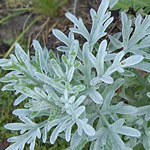 |
| Artemisia stelleriana 'Silver Brocade' Wormwood |
A superior recent introduction, this plant exhibits a remarkable range of adaptability, being equally at home as a ground cover in a coastal garden or a frigid mountain planting. The felt-like white foliage provides a fine carpet to plant under other xeric perennials. Prompt deadheading of the white flower spikes in midsummer will maintain its rug-like look. Well adapted to varying soil types and watering regimes.
|
 |
| Aruncus aethusifolius Goat's Beard |
This dwarf goat's beard is a clump-forming perennial which typically grows to only 12" tall. Features fern-like, compound, 3-4 pinnate, dark green leaves which form a foliage mound to 4-6" tall. Astilbe-like plumes of tiny, creamy white flowers rise above the foliage to 12" tall in late spring. Prefers part shade, particularly in the southern part of its growing range. Removing faded flower stalks will not prolong bloom, but may improve plant appearance, particularly if a ground cover look is desired. On the other hand, flower stalks may be left in place to enjoy the continuing ornamental effect of the dried seed plumes. Generally does not perform well in the hot and humid conditions of the deep South (USDA Zones 8-10). Plants can be slow to establish.
|
 |
| Aruncus dioicus Goat's Beard |
This species of goat's beard is a Missouri native plant which occurs in moist woodlands and along bluffs in the central and southeast part of the State. A tall, erect, bushy, clump-forming plant typically growing 4-6' high which features pinnately compound, dark green foliage and showy, plume-like spikes of tiny, cream colored flowers which rise well above the foliage in early to mid summer, creating a bold effect. This rose family member is somewhat similar in appearance to Astilbe.
|
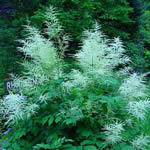 |
| Aruncus dioicus 'Kneiffii' Goat's Beard |
'Kneiffii' typically grows to only 3' tall and features pinnately compound, rich green foliage which is deeply cut into thread-like segments and plume-like spikes of tiny, cream colored flowers which rise above the foliage in late May. This rose family member is somewhat similar in appearance to Astilbe. Easily grown in average, medium to wet, well-drained soil in full sun to part shade. Best in moist, fertile soils. Foliage decline can be rapid if soils are permitted to dry out. Prefers part shade, particularly in the southern part of its growing range. Does not perform well in the hot and humid conditions of the deep South.
|
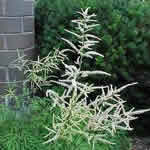 |
| Aruncus sinensis 'Zweiweltenkind' Goat's Beard |
Bold, showy plant for a moist or partly shaded spot. Large plume flowers dance above light green foliage with tan tints. Excellent foil for the back of the border,and also perfect for a woodland garden.
|
 |
| Asarum canadense Wild Ginger |
Wild ginger is a native spring wildflower which occurs in rich woods and wooded slopes. Basically, it is a a stemless plant which features two downy, heart-shaped to kidney-shaped, handsomely veined, dark green, basal leaves (to 6" wide). Cup-shaped, purplish brown flowers (1" wide) appear in spring on short, ground-level stems arising from the crotch between the two basal leaves. Flowers are quite attractive on close inspection, but bloom singly on or near the ground and are usually hidden from view by the foliage. Although not related to culinary ginger (Zingiber officinale), the roots of this plant produce a scent that is reminiscent of ginger.
|
 |
| Asarum Caudatum |
This evergreen groundcover, also known as long-tailed wild ginger, has beautiful heart-shaped leaves. The flowers peek out from beneath the leaf canopy. Best grown in a shady location, in humus rich, well-drained soil with low fertilizer. Commonly found in moist forest settings, it is also tolerant of low water situations once it is established. is native to rich moist forests of western North America from British Columbia to California and as far east as western Montana. In spring, it develops distinct hirsute cup-shaped, brown-purple to green-yellow flowers with three long gracefully curved lobes or “long tails” which are often concealed by leaves. The leaves emit a ginger aroma when rubbed and the root has a spicy smell similar to culinary ginger when crushed. Ground-Cover
|
 |
| Asarum europaeum European Wildginger |
3 in., shiny evergreen foliage, shade, ground cover, massing, Zone 5-8 |
 |
| Asclepias incarnata Swamp Milkweed |
4-5 ft., pink flowers, sun, moist, summer blooming, native, Zone 4-9 |
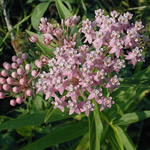 |
| Asclepias incarnata 'Ice Ballet' Ice Ballet |
3 ft., white flowers, Summer blooming, native, Zone 4-9 |
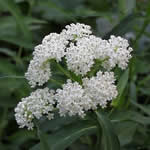 |
|
Asclepias purpurascensPurple Milkweed |
An exceptionally lovely native that is rarely found in cultivation. Purple Milkweed has intense rose pink flowers for several weeks in early to mid summer, followed by the attractive pods of silky seeds typical of the genus. Very tolerant of a wide variety of soils and light levels, it is easy to grow. Tolerates shade, but blooms better in the sun. Once established it becomes drought tolerant. It is a good noninvasive substitute for Asclepias syriaca, in the native garden or meadow restoration as it is less aggressive but still resembles it in appearance. The flowers of Purple Milkweed are usually a deeper color of purple. The seedpods are also exceptional without “prickles.” It is a meadow native of the Northeast.
|
 |
| Asclepias tuberosa Butterfly Weed |
2-3 ft., orange flowers, sun, border, native, Zone 4-8 |
 |
| Asclepias tuberosa 'Gay Butterflies' Gay Butterflies |
2-3 ft., mixture of yellow, orange and red flowers,Zone 4-8 |
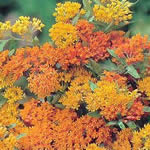 |
| Asphodeline lutea King's Spear |
3-4 ft., narrow foliage, bright yellow flowers, blooms late Spring or early Summer, Zone 6-8 |
 |
| Aster carolinianus Climbing Aster |
sun, massing, blooms early Fall, 16-10 ft., rose pink to purple flowers, 3-4 in. sword-like leaves on woody stems, large plant, blooms late Sept-Oct, Zone 6-9 |
 |
| Aster coridfolius Blue Wood-Aster |
Size: 2 ½’ x 2 ½’, sun - shade (flowers in 3+ hours of sun), Native. Soft flowers in early fall in shade. Handsome planting under trees or at wood’s edge for softening. Pairs nicely with Astilbes or as the third-season filler around Hostas in a woodland garden. Naturally found in woods and dry meadows with one inch flowers that cover the tops of the tall plants from a dark blue to a slightly pale blue almost white with yellow centers. Unlike the wildform, this variety is upright and attractive with heart shaped lower leaves. Nice cut flower for fall. Excellent choice for meadow plantings. Zone 5-8
|
 |
| Aster divaricatus White Wood Aster |
sun, massing, blooms early Fall, 2 ft., white flowers, shade and drought tolerant, Zone 4-8 |
 |
| Aster dumosus 'Alert' | sun, massing, blooms early Fall, 1 ft., reddish-purple flowers, Zone 4-8 |
 |
| Aster dumosus 'Blaue Lagune' Blue Lagoon |
sun, massing, blooms early Fall, 2 ft., clear blue flowers in Summer, part shade, Zone 4-8 |
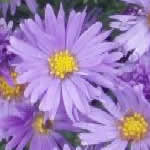 |
| Aster dumosus 'Nesthakchen' | sun, massing, blooms early Fall, 1 ft., bright pink flowers, Zone 4-8 |
 |
| Aster dumosus 'Professor Anton Kippenberg' | sun, massing, blooms early Fall, 2 ft., lavender-blue flowers with gold center, Zone 4-8 |
 |
| Aster dumosus 'Lady in Blue' | sun, massing, blooms early Fall, 15-18 in, light blue flowers, compact, blooms Aug-Sept, Zone 4-8 |
 |
| Aster ericoides Heath Aster |
sun, massing, blooms early Fall, 1-3' Bushy habit with clusters of delicate yellow-centered white flowers. Zone 3-8 |
 |
| Aster ericoides 'Snow Furry' | sun, massing, blooms early Fall, 1-2 ft., white flowers with yellow eye, Zone 4-8 |
 |
| Aster frikartii 'Moench' | 2-3 ft., blue flowers with gold centers, Zone 4-8 |
 |
| Aster frikartii 'Wunder von Staefa'' | 2-3 ft., light blue, blooms late Summer, Zone 4-8 |
 |
| Aster laevis Smooth Aster |
sun, massing, blooms early Fall, 2-4' An abundance of violet-blue flowers. A hardy aster, often blooming well into late fall, Zone 4-8 | |
| Aster laevis 'Bluebird' | sun, massing, blooms early Fall, 3-4 ft., violet-blue flowers with yellow center, vase-shaped clump, Zone 4-8 | |
| Aster lateriflorus 'Horizontalis' | sun, massing, blooms early Fall, 2-3 ft., pale lilac flowers, purplish leaves, Zone 4-8 | |
| Aster lateriflorus 'Lady in Black' | sun, massing, blooms early Fall, 3 ft., small black foilage w/small white flowers, sun to part shade, native to eastern USA, blooms Sept-Oct, Zone 6-8 | |
| Aster macrophyllus | sun, massing, blooms early Fall, 2-3 ft., violet flowers, great under shrubs and tree, full-part shade, Zone 4-8 | |
| Aster macrophyllus 'Albus' | sun, massing, blooms early Fall, 2-3 ft., white flowers, Zone 4-8 | |
| Aster novae-angliae New England Aster |
sun, massing, blooms early Fall, 4 ft., violet to pink shades, Zone 4-8 | |
| Aster novae-angliae 'Andenken an Alma Potschke' | sun, massing, blooms early Fall, 3-4 ft., salmon pink flowers, Zone 4-8 | |
| Aster novae-angliae 'Harrington's Pink' | sun, massing, blooms early Fall, 4-5 ft., pink flowers, Zone 4-8 | |
| Aster novae-angliae 'Purple Dome' | sun, massing, blooms early Fall, 3-4 ft.,semi-double purple flowers, Zone 4-8 | |
| Aster novae-angliae 'Rudelsburg' | sun, massing, blooms early Fall, 3-4 ft., brilliant salmon flowers, an improved version of 'Harrington's Pink', Zone 4-8 | |
| Aster novi-belgii New York Aster |
sun, massing, blooms early Fall, 3-4' Mixed blue, pink and white flowers. Prefers average to moist soils. Zone 3-8 | |
| Aster novae-belgii 'Blue Gown' | sun, massing, blooms early Fall, 2.5-3 ft., clear blue flowers, blooms Sept-Oct, Zone 3-8 |
 |
| Aster novae-belgii 'Marie Ballard' | sun, massing, blooms early Fall, 2-3 ft.,double blooming light blue flowers, Zone 4-8 |
 |
| Aster novae-belgii 'Patricia Ballard' | sun, massing, blooms early Fall, 3-4 ft., light pink flowers, Zone 4-8 | |
| Aster oblongifolius 'October Sky' | sun, massing, blooms early Fall, 1.5-2 ft., strong grower, low mounds of bushy 18 in. foilage, spreading 18-24 in. with blue flowers, highly tolerant of drought and poor soil, Zone 4-8 | |
| Aster oblongifolius 'Raydon's Favorite' | sun, massing, blooms early Fall, 3 ft., single med-blue flowers, fragrant foliage, blooms Sept-Oct, Zone 4-8 | |
| Aster pringlei 'Monte Cassino' | sun, massing, blooms early Fall, 4 ft., white flowers, Zone 4-8 | |
| Aster spectabilis Seaside Aster |
sun, massing, blooms early Fall, 18 in., blue single flowers, hot, sunny, dry poor or sandy soils, deep green foilage, native to USA, attracts butterflies, Zone 4-8 | |
| Aster tataricus | sun, massing, blooms early Fall, 6-8 ft., blue-purple flowers, Zone 4-10 | |
| Aster tataricus 'Jindai' Tatarian Daisy |
sun, massing, blooms early Fall ,3-5 ft., deep green foilage with single sky-blue flowers, Zone 4-8 | |
| Asteromoea mongolica (Kalimeris m.
) Beauty Aster |
2-3 ft., white flowers during summer, Zone 4-8 | |
| Astilbe 'Cattleya' False Spirea |
part shade, massing, groups, 3 ft., orchid-pink flowers, sun, blooms June-July, Zone 5-8 | |
| Astilbe chinensis | part shade, massing, groups, 2-3 ft., light purple flowers, dull green foliage, blooming in Summer, Zone 5-8 | |
| Astilbe chinensis 'Finale' | part shade, massing, groups, 2 ft., salmon pink flowers, good ground cover, blooms July-August, Zone 5-8 | |
| Astilbe chinensis 'Pumila' Dwarf Chinese Astilbe |
part shade, massing, groups, 8 in., light purple flowers, rock garden, ground cover, Zone 5-8 | |
| Astilbe chinensis 'Purpurkerze' | part shade, massing, groups, (A. taquetii 'Purpurkerze'), 3 ft., tall upright plumes, rosy purple, blooms in August, Zone 5-8 | |
| Astilbe chinensis 'Veronica Klose' | part shade, massing, groups, 1-2 ft., dark purple flowers in late Summer, Zone 5-8 | |
| Astilbe crispa 'Lilliput' | part shade, massing, groups, 8-10 in., rose plumes, false spirea, blooms June-July, Zone 5-8 | |
| Astilbe crispa 'Perkeo' | part shade, massing, groups, 8 in., rose pink, crinkled dark green foilage, blooms mid-late Fall, Zone 4-9 | |
| Astilbe 'Deutschland' | part shade, massing, groups, 2 ft., snow-white flowers in late Spring, Zone 5-8 | |
| Astilbe 'Diamant' | part shade, massing, groups, 2-3 ft., white flowers. Zone 6-9 | |
| Astilbe 'Erika' | part shade, massing, groups, 2 ft., pink flowers, blooms June-July, Zone 5-8 | |
| Astilbe 'Europa' | part shade, massing, groups, 1-2 ft. light pink flowers May-June, Zone 5-8 | |
| Astilbe 'Fanal' | part shade, massing, groups, 2 ft., intense red flowers in July, reddish foliage, Zone 5-8 | |
| Astilbe 'Superba' | part shade, massing, groups, (A. taquetii superba), 3 ft., purple-rose flowers, late bloomer, Zone 5-8 | |
| Astilbe arendsii hybrid 'Brautchleier' Bridal Veil |
part shade, massing, groups, 2-3 ft., white flowers in June, Zone 5-8 | |
| Astilbe arendsii hybrid microphylla 'Montgomery' | part shade, massing, groups, 1-2 ft., deep red flowers in June, Zone 5-8 | |
| Astilbe arendsii hybrid microphylla 'Peach Blossom' | part shade, massing, groups, 2 ft., salmon-pink flowers in July, Zone 5-8 | |
| Astilbe arendsii hybrid microphylla 'Red Sentinel' | part shade, massing, groups, 1-2 ft., ruby-red flowers w/ bronze foliage, mid bloomer, Zone 5-8 | |
| Astilbe arendsii hybrid microphylla 'Rheinland' | part shade, massing, groups, 2 ft., clear rose carmine flowers in June, Zone 5-8 | |
| Astilbe simplicifolia hybrid 'Hennie Graafland' | part shade, massing, groups, 15 in., rose flowers above dark shiny cut foliage, blooms June-July, Zone 5-8 | |
| Astilbe simplicifolia hybrid 'Snowdrift' | part shade, massing, groups, 2 ft., white flowers, early bloomer, Zone 5-8 | |
| Astilbe simplicifolia hybrid 'Sprite' | 1994 PPA Plant of the Year, part shade, massing, groups, 1 ft., light pink flowers above green lacy cut foliage, late bloomer, Zone 5-8 | |
| Astilbe simplicifolia hybrid 'Straussenfeder' | part shade, massing, groups, (A.'Ostrich Plume'), 3 ft., salmon-pink flower heads in summer, drooping, posture, Zone 5-8 | |
| Astilbe simplicifolia hybrid thunbergii 'Vesuvius' | part shade, massing, groups, 2 ft., red flowers in summer, Zone 5-8 | |
| Astilboidies tabularis | (Rodgersia tabularis), 2-3 ft., blooms white May-June, shade, specimen perennial, Zone 6-8 | |














































































































